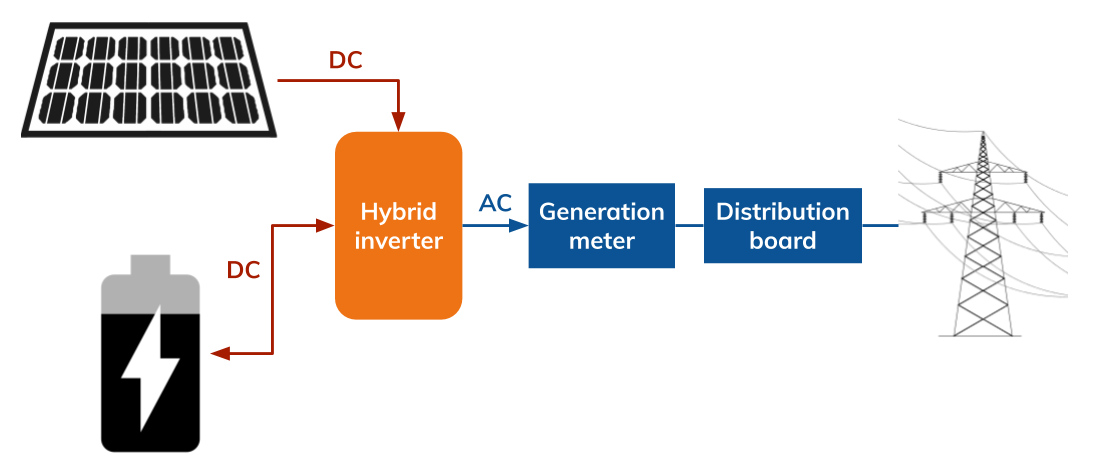
Traditionally, an inverter is the component in a solar system that converts the DC power from the panels into AC power suitable for the home appliances and national grid. A hybrid inverter fulfils this purpose, while also sending DC power to a battery to conserve it for later use, and from the battery when required.

Many hybrid inverters are made to be compatible with high voltage batteries, but you can also get hybrid inverters integrated directly into a battery.
There are a few benefits to using a hybrid inverter with DC coupled batteries:
Unfortunately many of us are out during the daytime, when our solar panels are producing the majority of their power. Some of that will be used for background loads (fridges etc) but any excess is typically sent to the grid… unless you can store it.
With battery storage, you can save up the energy you generate throughout the day and use it in the evenings. It can increase the proportion of demand covered by solar by about 20% on average. Alongside this, you can take advantage of other battery benefits like power cut backup and buying cheap off-peak electricity to use during peak hours.
In the old days, off-grid batteries were DC coupled. In domestic settings, more recent batteries are AC coupled, particularly when retrofitted to existing solar systems with AC inverters. This means you don’t need a hybrid inverter to attach a battery to your system. In fact, our top recommended battery - Tesla Powerwall 2 - is AC coupled.
If all this talk of AC and DC coupling has got you confused, let’s try to break it down.
DC is direct current. It’s the form of power generated by solar panels and used by batteries.
AC is alternating current. It’s the form of power used by appliances in our homes and for transmitting electricity across the grid, as it’s more stable over long distances.
Conversion between AC and DC (or vice-versa) will result in some power loss. For comparison, here’s a DC coupled battery with a hybrid inverter:

And here’s an AC coupled battery with solar and battery inverters:

As you can see, energy going to the battery in the AC coupled example has to be converted twice (DC-AC then AC-DC), increasing the losses. Then when you come to use that energy, it has to be converted again (DC-AC), adding even more loss into the system. So in total, a DC coupled system has one conversion, while an AC coupled system has three.
Hybrid inverters are well worth considering when installing a new PV system with storage, which is becoming increasingly common with newbuild properties. If you already have PV and are looking to add a battery, then it’s not economically beneficial to take out your existing inverter and replace it with a hybrid. Instead you can go for an AC coupled battery, like our recommended Powerwall 2.
Find out more in our guide to residential battery storage:
SolarEdge’s StorEdge
SolaX Hybrid
Copyright © Spirit Energy 2026 · info@spiritenergy.co.uk · 0118 951 4490
Jobs and Careers
Interested in joining the Spirit team? Email jobs@spiritenergy.co.uk
Spirit House, 25 Albury Close, Reading, RG30 1BD
(Location formerly known as 44 Portman Road, Reading, RG30 1EA)
Spirit Energy is the trading name of Spirit Solar Ltd · UK Company Number 07138647
Although care is taken to ensure that the information on our website (www.spiritenergy.co.uk) and any guides, calculators or checklists provided by us, electronically or otherwise, are accurate and up-to-date, we cannot accept any responsibility for mistakes or omissions. We enter into no express or implied conditions, warranties, terms or representations regarding the quality, accuracy or completeness of the information. We exclude to the extent lawfully permitted all liability for loss or damage, whether direct, indirect or consequential arising out of your use of our website or any guides, calculators or checklists provided by us, or from any information or omission contained in our website or any guides, calculators or checklists provided by us.